Posted by Elena del Valle on November 21, 2013

Symphony of the Soil movie poster – click to enlarge
Video, photos: Lily Films
It took filmmaker Deborah Koons Garcia four years and much work to complete Symphony of the Soil, a 104-minute documentary film about the complexity and mystery of soil. Filmed on four continents and featuring the insights of dozens of experts including some of the world’s most esteemed soil scientists, farmers and activists, the insightful film portrays soil as an essential element for our survival. Scroll down to the watch film trailer.
Relying on striking cinematography by John Chater, and Nancy Schiesari in the United Kingdom, combined with art and animation the director illustrates the pivotal role of soil in our world. Experts on screen expound the importance of good soil in solving some of the planet’s most vexing environmental and healthy food supply problems.
The first third of the documentary focuses on soil science. How soil is formed and its life cycle as well as the physical components of soil, the soil orders, the microorganisms that cycle nutrients, soil and plants, and the interrelationship of the many members of the soil community, including humans.
The second third of the film focuses on the relationship between people and soil, especially human’s use of soil for agriculture. The third section explores soil and climate change, water use, health and other topics that support the case for treating soil with care such as the return to small scale organic farming as a viable solution to the problems of resource depletion, climate change and the end of oil; and to the importance of seeds and seed saving in India.

Sekem calendula field
Symphony of the Soil is the second major production of Lily Films. In it the film producers strive to raise consciousness about how people think and treat soil, seeking that they realize that destructive land use practices degrade and poison the soil and that society should take responsibility for protecting and improving soil for the generations to come.
It was filmed on four continents, in six countries, the United States, England, Wales, India, Egypt, and Norway. Some of the locations include, in the United States, Oregon, Washington, California, New York, West Virginia, Kansas, Iowa, Vermont, Hawaii; in the United Kingdom, Devon, Hastings, Bristol, Wales, and Ceredigion; in India, Punjab, Uttarakhand, Rajasthan; in Egypt, Cairo and Aswan; and in Norway, Tromso.
The film was Winner of the Life Sciences Film Festival, Prague 2012, Merit Award for Scientific Information from the Montana CINE International Film Festival, September 2012, and Winner of the 2013 Cinema Verde Film Festival’s Food Award. Koons Garcia received the John de Graaf Environmental Filmmaking Award for her body of films on agriculture, genetically modified food and sustainability at the Wild and Scenic Film Festival, January 2013.
Koons Garcia, a bay area filmmaker, has made fiction, educational and documentary films. For the last ten years, she has focused on films about agriculture, the food system and environmental issues. Lily Films, her film production company based in Mill Valley, California, funded the lion’s share of the production costs for the documentary.
Posted by Elena del Valle on November 18, 2013
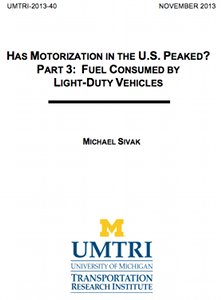
U.S motorization study by Michael Sivak
In 2011, based on the most recent data available, the average driver in the United States consumed 585 gallons of fuel or 1,033 gallons per household. Recent studies indicate that Americans, in general, own fewer light-duty vehicles, drive each of them less, and consume less fuel than in past years.
According to the results of a study (one of three on the subject conducted) released this month, researchers believe fuel consumption rates per person, per licensed driver, per household, and per registered vehicle and distance-driven rates peaked in 2003 or 2004, before the ongoing economic downturn.
By 2011, they had decreased by 13 percent to 17 percent. The researchers believe the long term peak was reached around 2003 or 2004.
They concluded Americans drive fewer light-duty vehicles, defined as cars, pickup trucks, SUVs, and vans; they drive each of them less, and consume less fuel. They also estimate that current fuel consumption rates are lower than they were in 1984 when they began to track the information.
The 17-page report, titled Has Motorization in the U.S. Peaked? Part 3: Fuel consumed by light-duty vehicles was authored by Michael Sivak, director, Sustainable Worldwide Transportation, University of Michigan Transportation Research Institute. Earlier this year, he published two reports in which he looked at recent trends in the numbers of registered light-duty vehicles in the United States and the corresponding distances driven.
Posted by Elena del Valle on November 15, 2013
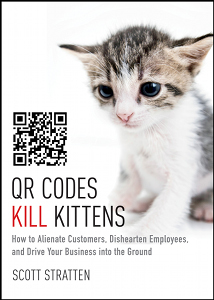
QR Codes Kill Kittens
Photos: Wiley
A quick response code or QR code for short is a type of bar code that requires a smart phone and an app to read it. According to Wikipedia, it is a kind of two-dimensional barcode that can be read optically by a machine. It is used to read information. If the app is able to read the QR code it was made correctly. Once the app reads the code it should lead the user to a mobile device friendly link or website.
QR codes have become common marketing tools, appearing on products, billboards, bus stops and so forth. The problem, according to Scott Stratten, president of UnMarketing, is that most QR codes don’t work. He believes it is because many people are too focused on using codes without paying enough attention to functionality. He proposes that if it mattered people would make sure they worked when they launch them.
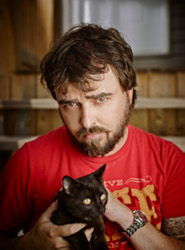
Scott Stratten, author, QR Codes Kill Kittens
“If you knew that your terrible business decisions could cost a kitten its life, would you still do it? Of course not. No one wants to hurt a kitten, and no one wants to damage their own business through easily avoidable mistakes. The trick is, knowing which things are the wrong things to do,” Stratten said.
To make his point he wrote QR Codes Kill Kittens: How to Alienate Customers, Dishearten Employees, and Drive Your Business into the Ground (Wiley, $18), a 196-page hardcover small book focused on what goes wrong when QR codes don’t work.
The four color book is easy to read and often humorous. It includes photos on almost every page. It is divided into four sections designed to showcase why QR codes represent what’s wrong with business today including; They Don’t Work, Nobody Likes Them, They are Selfish and They Take Up Valuable Time Better Spent Elsewhere. Stratten, ranked among the top online influencers by Forbes.com, is also author of Unmarketing.
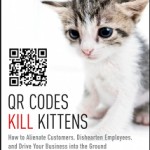
Click to buy QR Codes Kill Kittens
Comments:
Filed Under: Books
Posted by Elena del Valle on November 8, 2013
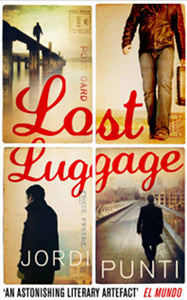
Lost Luggage
Photos: Atria Books / Marble Arch Press
Jordi Punti, a writer and translator, and a contributor to the Spanish and Catalan press, was rewarded with recognition when he released his first novel. Lost Luggage (Atria Books / Marble Arch Press, $16), published in English in paperback and e-book editions in October 2013, was translated into 15 languages, and won the Spanish National Critics’ and the Catalan Booksellers prizes. Prior to this title Punti published three books of shorts stories.
In the 440-page book, Cristofol, a young Barcelona resident, is informed by the police that his father’s flat has been abandoned and its owner is missing. The man who vanished, a truck driver, left Cristofol and his mother 20 years earlier. At the apartment he had never heard about Cristofol finds a list of names belonging to his half brothers Christof, Christophe, and Christopher. He contacts them. None of them was aware that he had half siblings from a common father. None of them had seen his father in many years.
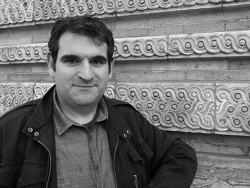
Jordi Punti, author, Lost Luggage
Although they live in different European cities they decide to meet for the first time. They wonder why he abandoned them and why they have similar names. In their journey to find the answers they discover a man who during 30 years of driving was able to escape the darkness of Spain under its former president Francisco Franco and to explore Europe.
Since he received a degree in Romance Philology in 1991, Punti has worked in Barcelona publishing houses, and co-directed La Flor Inversa (The Inverse Flower), a collection of medieval poetry along with Jordi Cerdà and Eduard Vilella, according to lletra.net.

Click to buy Lost Luggage
Comments:
Filed Under: Books
Posted by Elena del Valle on November 4, 2013

Lara Pizzorno, MDiv, author, Your Bones
Photos: Praktikos Books
A podcast interview with Lara Pizzorno, MDiv, author, Your Bones (see Former osteopenia sufferer, doctor share natural path to healthy bones), is available in the Podcast Section of Hispanic Marketing & Public Relations, HispanicMPR.com. During the podcast, she discusses her book and bone health with Elena del Valle, host of the HispanicMPR.com podcast.
A member of the American Medical Writers Association with 29 years of experience writing for physicians and the public, Lara is editor of Longevity Medicine Review as well as senior medical editor for SaluGenecists, Inc., and Integrative Medicine Advisors, LLC. Your Bones was recently translated into German and Polish.
She is contributing author to the Textbook of Functional Medicine, articles for Integrative Medicine: A Clinician’s Journal, and Textbook of Natural Medicine; lead author of Natural Medicine Instructions for Patients; co-author of The Encyclopedia of Healing Foods; and editor, The World’s Healthiest Foods Essential Guide for the healthiest way of eating.
To listen to the interview, scroll down until you see “Podcast” on the right hand side, then select “HMPR Lara Pizzorno, MDiv” click on the play button below or download the MP3 file to your iPod or MP3 player to listen on the go, in your car or at home. To download it, click on the arrow of the recording you wish to copy and save it to disk. The podcast will remain listed in the November 2013 section of the podcast archive.

Click to buy Your Bones
Posted by Elena del Valle on November 1, 2013
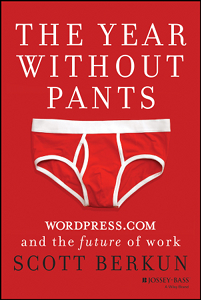
The Year Without Pants
Photos: Jossey-Bas
Scott Berkun, a Microsoft veteran with a corporate background who had authored four books, wondered whether he would follow his own advice if he were back in the workforce trenches. An opportunity to test his theory arrived when he was invited to lead a team of programmers at WordPress.com from 2010 to 2012. He agreed on condition that as a participatory journalism exercise he would write about his experience and the lessons he learned.
In The Year Without Pants and the Future of Work (Jossey-Bass, $26.95), he outlines the highlights of the experience as he saw them. He includes a behind the scenes look at Automattic, the firm he thinks drives WordPress.com’s success. The 258-page hardcover book published in 2013 is divided into 24 chapters.
His biggest challenge the author said by email was that “As an expert I had to put my expertise to the test, and find out: what of my own advice do I practice? And how will I adjust to a workplace with no email and no offices?”

Scott Berkun, author, The Year Without Pants
Every month 396 million people view more than 14 billion pages in 120 languages at WordPress.com. As of this writing, there are 72 million blogs around the world; users produce 36 million new posts and 62 million comments per month, according to the company website. He believes other businesses can take advantage of the insights he gleaned first hand from working there.
“I learned the future of work can be wonderful if managers are willing to reevaluate what’s possible, based on the examples WordPress.com has provided,” he said when asked what was the biggest reward he received from the project.
In the book, he explores workplace issues at WordPress.com such as how he thinks the company’s decentralized workplace, relying on 170 employees in 70 different cities, is creative and productive. He draws attention to the company’s “culture of self-sufficiency and experimentation.”
And he considers how the use of blogs, chat and Skype in lieu of email to communicate make it efficient. It’s possible, he says in the final chapter, that technology companies like Automattic are returning work to its roots and away from the absurdity of work that exists in many white collar environments; and that they might return some of the meaning of work the business world has lost.
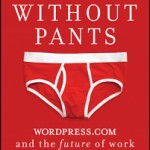
Click to buy The Year Without Pants
Comments:
Filed Under: Books























